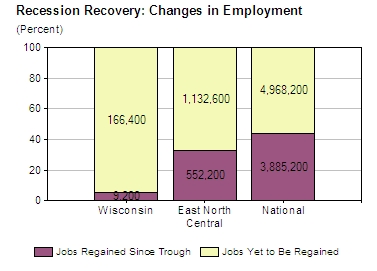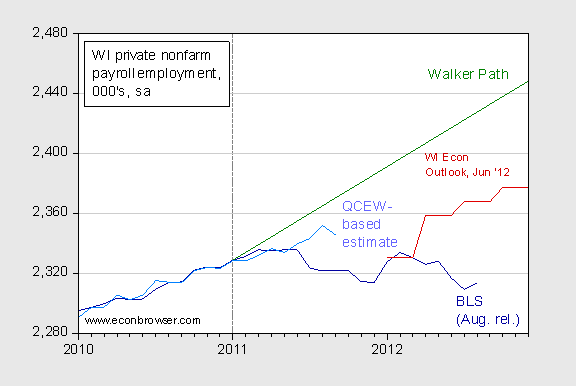From IHS-Global Insight, “U.S. Regional – Perspective Article: Swing States: Wisconsin,” 9/24/2012:
The employment picture in Wisconsin so far this year has been grim. Whereas the country has seen year-on-year (y/y) job growth above 1.0% each month through July, the Badger State has seen y/y declines every month. As of July, Wisconsin payrolls had shed 0.8% since the same time last year. Although the state’s important manufacturing sector is creating jobs, expanding at a 1.3% pace since July 2011, many other sectors continue to decline. The already beleaguered construction sector continues to be pummeled, shedding 7.7% y/y in July because of continued weak demand for new single-family homes and a lack of public infrastructure projects. And contrary to the trend throughout most of the country, where professional and business services has been a stalwart of the recovery, that sector’s payrolls have declined 0.8% here. In addition, leisure and hospitality services jobs declined 6.7% from their July 2011 level. The finance sector continues to suffer as well, dropping 1.8% y/y in July. Although the state’s jobless rate has remained below the national average, it continues to climb, with July bringing more bad news, when it climbed to 7.3% from 7.0% in June.
The following graph presents the Wisconsin situation vis a vis the region, and the US (through July):

Source: IHS-Global Insight, 9/24/2012.
The figure makes clear that Wisconsin is clearly underperforming. My personal view is that the belief in the possibility of expansionary fiscal contraction on the part of the Walker Administration might explain some of the divergence. (Perhaps the specificity of the Wisconsin macro conditions (i.e., Walker’s fiscal policies) explains why the state is leaning Democratic, despite a poor employment situation.)
[0]
Now, as is well known, there is some controversy surrounding the accuracy of the BLS establishment based estimates of state employment [1] [2]. As the WI DWD press release yesterday notes:
The most accurate count of jobs data, the Quarterly Census of Employment and Wages (QCEW), is based on a census of approximately 96 percent of Wisconsin employers. DWD last week submitted unemployment insurance (UI) records for the first three months of 2012 to the federal government. The UI administrative data show private sector job growth of 37,464 from March 2011 to March 2012. The federal government will incorporate the data in its next QCEW release covering the first quarter of 2012 for all states.
In a previous post, I’ve tried to take into account the QCEW data. I plot the implied private payrolls data with the official BLS data, the Wisconsin Economic Outlook forecast from June, and Governor Walker’s promise to create 250,000 additional jobs by 2016.

Figure 1: BLS estimate of Wisconsin private nonfarm payroll employment from CES (blue), QCEW based estimate of WI nonfarm payroll employment minus government employment (light blue) [see post], forecast from June Wisconsin Economic Outlook (red), and Walker path for additional 250 thousand jobs by 2016 (green). Source: BLS (August release), Wisconsin Economic Outlook (June 2012), author’s calculations.
Even if one shifts up the BLS series to account for the QCEW data up to 2011M09, it’s clear the gradient is negative over 2012 thus far. What about employment prospects? The report continues:
The remainder of the year will bring little good news to Wisconsin’s beleaguered labor market. Payroll growth will be flat in the second half, despite an average expansion of 1.4% among all US states. Construction will continue to suffer, dropping an additional 4.7%, with losses tapering off in the early portion of next year. The important professional and business services sector will continue to hinder recovery in the state, with payrolls remaining flat in the second half. Leisure and hospitality will drop an additional 2.1%. Further cuts at both the state and federal level mean that government employment will fall an additional 1.0%. Factory employment will continue to buoy Wisconsin, where durables manufacturing will add 2.3%. Education and health services will continue to grow modestly, adding 0.7% in the second half.
The August unemployment rate (preliminary) has risen to 7.5% from 7.3 in July, and from 7.0% in December of 2011.
Update, 2:45 Pacific, 9/29: In other news, the Walker Administration has experienced some difficulties in spending money in accordance with law and policies. From Wisconsin State Journal:
A federal agency has ordered the state to improve the way it handles economic-development money from the U.S. Department of Housing and Urban Development.
In a strongly worded Aug. 12 letter to Department of Administration Secretary Mike Huebsch, federal officials said two state agencies failed to follow federal law and their own policies in issuing economic development grants.
Among the findings:
- The state gave out aid worth $20,000 per job created to Kapco, a company with a plant in Polk County — twice as much as its own policies allow.
- Officials failed to check the financial soundness of two companies receiving $1.4 million in federal grants.
- Eleven out of 20 loans using Community Development Block Grant funds awarded since Jan. 1, 2011, are “forgivable,” despite the fact that the state’s own policy calls for allowing businesses to get no-payback loans only in “extraordinary circumstances.”
- Questions remain about an $8.6 million chunk of CDBG funds withdrawn under unusual circumstances late last year.
…
And from the Milwaukee Journal Sentinel:
In a letter sent late Wednesday, Paul Radspinner, president and chief executive officer of FluGen Inc., wrote that he and other WEDC board members should have been told long ago of the issues, which were first raised by the U.S. Department of Housing and Urban Development more than a year ago. The board met as recently as last week but was never given detailed information about the problems, which came to light publicly Wednesday.
“It is unconscionable that the WEDC staff would consider this issue not important enough to share with the board at the June meeting let alone last week’s meeting,” Radspinner wrote.…
A May 2012 letter from HUD shows that Walker’s administration was warned in August 2011 that HUD did not recognize the economic development corporation’s ability to administer federal money but that Walker went on in February 2012 to announce the agency was awarding federal money to several Wisconsin cities.
The GOP governor and lawmakers last year dissolved the state Department of Commerce and created the economic development corporation, which they said would be more effective at sparking the economy. Its board consists primarily of businesspeople, but also lawmakers from both parties.
Well, that settles it.
You have been right about Walker from the very beginning, although I’m sure your idiot critics , who appear regularly in the comments section, will quibble about this or that.
The bottom line is that the numbskull Walker has been a dead-loss for the people of Wisconsin.
Ahh, if only he had been impeached.
Menzie,
It is still too early. Let’s see how things improve for Gov. Walker under President Romney.
I continue to be amazed at how the terms of debate change. We (intentionally) forget a substantial reason behind Walker’s moves was the resulting confidence in the state’s business climate would generate economic growth. The idea was that WI would be relatively more competitive due to confidence among “suppliers”, meaning the supply side of the economy.
To believe this has occurred at all, you need to believe WI would be substantially worse off now without these confidence policies. Is WI doing better than neighboring states? No. It is doing worse. Are there specific reasons, like the sudden shifting of an industry overseas, that may explain why WI is doing worse? No.
Walker has been and continues to be a disaster. I am surprised his record on jobs is not used as an example at the national level of the tremendous failure of “austerity” policies.
johnathan,
You project your own imagination into what Gov. Walker faced. It is obvious from even a casual observation that the biggest problem Walker faced was a disasterous budget short-fall caused by a parasitic education union hold on state government. Walker’s entire time in office has been a battle against the power of the union thugs and bosses to hold on to their power and bank account in state government.
Yes, Walker’s policies will over time bring business back to Wisconsin but never forget that the union has not given up. Friendly courts are still throwing roadblocks up in the Wisconsin road to recovery.
If your true purpose is to see Wisconsin recover then let Walker’s programs be instituted. Otherwise we will simply see Wisconsin return to an economic basket case hosting the vampire education union as it sucks the blood out of the people.
Ricardo You continue to amaze. Once again you have managed to botch history. The public sector unions did not fight Walker over higher wages and benefits. The unions agreed to Walker’s proposed cuts. Walker wanted to cripple the unions because they represented the main organized institutional power supporting Democrats. The fight in Wisconsin did not have anything to do with the state’s budget woes. This was a political fight, not a budget fight.
But again, the point is not what Walker faced at all. That can be phrased to reflect any point of view. The point is that his plan was rooted in confidence, particularly in supply side confidence. The evidence is that hasn’t worked and not only because WI is doing badly; it’s doing worse than its neighbors. If the new argument is that WI somehow actually faced a worse situation than Illinois – or Michigan – or other states, that is demonstrably false. The point is that supply side confidence policy failed.
http://data.bls.gov/timeseries/LASRD92000005?data_tool=XGtable
“Walker faced was a disasterous budget short-fall”
On November 19th, 2010, the Department of Administration produced this report of revenue projections and agency requests which Walker cited in his Budget Proposal: http://www.doa.state.wi.us/docview.asp?docid=8371&locid=166
As you can add up on table 4 (page iv) the projected total of taxes, tribal gaming and other departmental revenue for GPR was $27,797,800,000 over the FY12/13 biennium.
As you can add up on Appendix 1’s table 1, the anticipated total of Federal, Program and Segregated revenue available to state agencies over FY12/13 was $37,060,421,200.
Adding these up you get $64,858,221,200 of revenue available to run the state government over FY12/13. On table 6 (page vi) you can see that the FY11 all funds total required to run all state agencies was looking to be $31,746,280,800.
Therefore freezing funding at FY11 levels would result in a $1,365,659,600 surplus.
That, however, is not the whole story. The ARRA’s Medicaid funds were not renewed by the Federal government, which left a $1,067,000,000 hole. Revenue estimates were revised upwards and so were agency requirements between then and budget time to the tune of a net $75,000,000 in revenue. The $200,000,000 raided from the Injured Patients and Families Compensation Fund and the $59,700,000 owed to Minnesota under the tax reciprocity agreement had to be repaid.
Put it all together, and there’s a $113,959,600 surplus. $54,400,000 would have to go into restoring the statutory minimum general fund balance, leaving $59,559,600 for agency increases, repaying debt and/or safety margin.
There was no disastrous budget shortfall, just accounting gimmicks from Walker sold to the state as an excuse to gut education funding, cut the EITC, raid the entireties of both the Wisconsin Election Campaign Fund and the Democracy Trust Fund, raid $26 million of the mortgage settlement funds, then give “job-creating” tax breaks that have led to one of the worst job creation records in the nation.
Menzie,
State governments, which can not run big deficits, can do very little fiscal stimulus to their own economies. State government policies can far more easily make business conditions worse by driving away businesses than the can make conditions better. What states can do to the positive are policies with mostly longer term effects. States can do very little in the short term to create sustainable better macroeconomic conditions.
Strong political partisanship lowers one’s effective intelligence.